The Moringa Oil Antioxidants Market is expected to record a valuation of USD 910.4 million in 2025 and USD 3,150.3 million in 2035, with an increase of USD 2,239.9 million, which equals a growth of 193% over the decade. The overall expansion represents a CAGR of 13.2% and a more than 2X increase in market size.
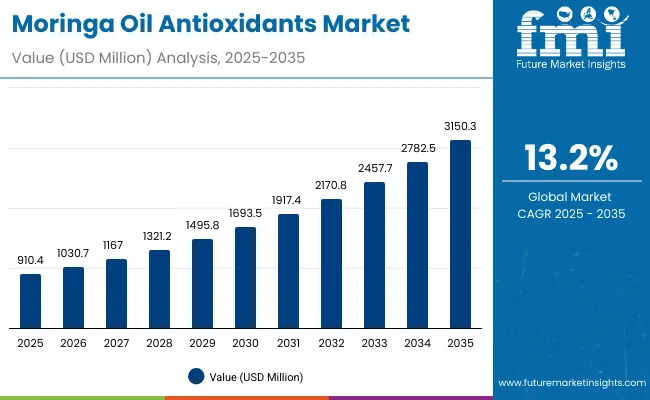
Moringa Oil Antioxidants Market Key Takeaways
| Metric | Value |
|---|---|
| Moringa Oil Antioxidants Market Estimated Value in (2025E) | USD 910.4 million |
| Moringa Oil Antioxidants Market Forecast Value in (2035F) | USD 3,150.3 million |
| Forecast CAGR (2025 to 2035) | 13.2% |
During the first five-year period from 2025 to 2030, the market increases from USD 910.4 million to USD 1,693.5 million, adding USD 783.1 million, which accounts for 35% of the total decade growth. This phase reflects steady adoption of moringa oil antioxidants in anti-aging serums, creams, and oils, driven by consumer demand for natural actives and multifunctional formulations. The anti-aging function segment dominates this period, as consumers seek effective botanical alternatives for skin rejuvenation.
The second half from 2030 to 2035 contributes USD 1,456.8 million, equal to 65% of total growth, as the market jumps from USD 1,693.5 million to USD 3,150.3 million. This acceleration is powered by the surge in natural/organic claims, premium product launches, and cross-border e-commerce expansion. By the end of the decade, oils and anti-aging formulations capture the largest shares, while clean-label and Ayurvedic-inspired claims gain stronger traction. Premiumization, scientific validation, and wider consumer accessibility through digital platforms will be the key drivers of long-term adoption.
From 2020 to 2024, the Moringa Oil Antioxidants Market grew steadily, supported by rising consumer preference for plant-based and multifunctional skincare solutions. During this period, the competitive landscape was shaped by regional players and global ingredient suppliers, with leaders like Marico and BASF focusing on high-quality extraction processes and supply chain integration. Competitive differentiation relied heavily on clean-label certifications, clinical validation, and heritage-driven marketing, while Ayurvedic-inspired brands leveraged cultural narratives to gain share.
Demand for Moringa Oil Antioxidants will expand to USD 910.4 million in 2025, and the revenue mix will shift further toward natural/organic claims (51.5%). Traditional global players face rising competition from digital-first beauty brands and nutraceutical entrants offering personalized, wellness-oriented solutions. Emerging startups specializing in Ayurvedic-inspired, vegan, and sustainability-certified formulations are gaining share. The competitive advantage is moving away from basic ingredient supply toward ecosystem strength, cultural relevance, and consumer trust built on scientific validation and clean-label positioning.
The Moringa Oil Antioxidants Market is expanding rapidly due to consumer demand for natural anti-aging products that address oxidative stress, fine lines, and skin elasticity. Moringa oil is rich in tocopherols and essential fatty acids, making it highly effective as a botanical alternative to synthetic antioxidants. Global brands are increasingly highlighting moringa’s anti-aging benefits in serums and oils, supported by clinical validation. This science-backed positioning, combined with clean-label claims, is pushing moringa oil antioxidants into the mainstream skincare category across premium and mass segments.
A unique growth driver comes from the premiumization of skincare combined with Ayurveda-inspired marketing in Asia-Pacific and global wellness markets. Moringa oil antioxidants are being positioned as multifunctional actives for moisturizing, repair, and brightening, appealing to consumers seeking holistic and culturally rooted solutions. Brands are leveraging Ayurveda and heritage narratives while simultaneously promoting sustainability and eco-friendly sourcing. This dual emphasis on tradition and modern efficacy enhances consumer trust and brand differentiation, enabling moringa oil antioxidants to gain traction in both luxury skincare and affordable mass-market offerings.
The market is segmented by function, product type, claim, distribution channel, and region, highlighting the diverse adoption of moringa oil antioxidants in skincare. Functions include anti-aging, moisturizing, brightening, and repair, with anti-aging emerging as the leading category due to moringa’s high tocopherol content and efficacy against oxidative stress. Product type classification covers oils, serums, creams/lotions, and masks, catering to both concentrated premium formats and mass-market applications. Based on claims, the segmentation includes natural/organic, vegan, clean-label, and Ayurvedic-inspired formulations, reflecting strong consumer demand for plant-based and heritage-driven beauty. Distribution channels span e-commerce, pharmacies, mass retail, and specialty beauty stores, with online platforms driving faster adoption across tier-1 and tier-2 markets. Regionally, the scope covers North America, Europe, and Asia-Pacific, with the highest growth rates in India and China, supported by cultural familiarity with botanicals and strong demand for multifunctional skincare solutions.
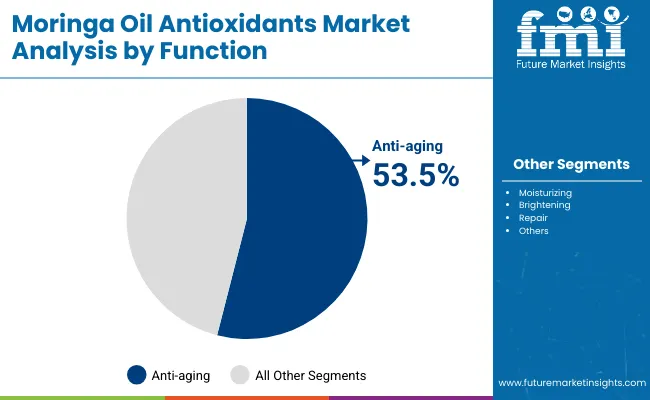
| Function | Value Share% 2025 |
|---|---|
| Anti-aging | 53.5% |
| Others | 46.5% |
The anti-aging segment is projected to contribute the largest share of the Moringa Oil Antioxidants Market revenue in 2025, maintaining its lead as the dominant functional category. This is driven by moringa oil’s high concentration of tocopherols, fatty acids, and natural antioxidants that help reduce fine lines, wrinkles, and oxidative stress. Brands are prioritizing anti-aging claims in serums, creams, and oils to meet consumer demand for effective plant-based alternatives to synthetic actives. The segment’s growth is also fueled by premium positioning and clinical validation, which boost consumer trust and adoption. As awareness of natural anti-aging solutions continues to expand, the anti-aging function is expected to remain the backbone of the Moringa Oil Antioxidants Market.
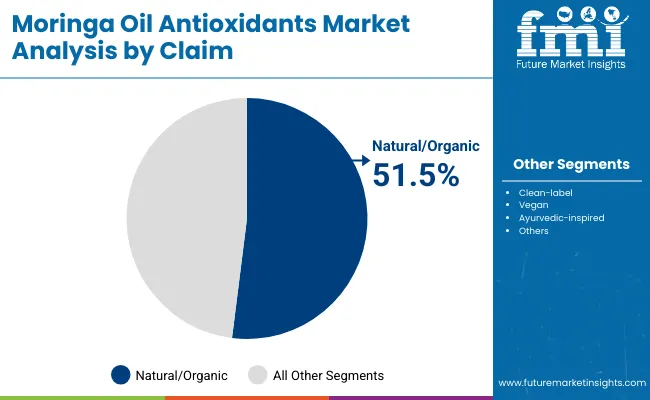
| Claim | Value Share% 2025 |
|---|---|
| Natural/organic | 51.5% |
| Others | 48.5% |
The natural/organic segment is projected to hold the leading share of the Moringa Oil Antioxidants Market in 2025, driven by consumers’ growing preference for plant-based, clean-label formulations over synthetic alternatives. Moringa oil antioxidants, known for their richness in vitamins and bioactive compounds, are increasingly used in serums, oils, and creams marketed as safe, eco-friendly, and multifunctional. This preference is reinforced by regulatory support in Asia and Europe for natural cosmetic claims, as well as the influence of the global wellness and sustainability movement. With brands focusing on traceable sourcing and ethical narratives, natural/organic products are expected to retain dominance and foster strong consumer loyalty.

| Product Type | Value Share% 2025 |
|---|---|
| Oils | 49.5% |
| Others | 50.5% |
The oils segment is projected to account for the largest share of the Moringa Oil Antioxidants Market revenue in 2025, establishing it as the leading product type. Oils are favored for their rich concentration of antioxidants, essential fatty acids, and vitamin E, which make them highly effective in moisturizing, repairing, and protecting the skin from oxidative stress. Their versatility allows use in pure form or as a base ingredient in serums, creams, and lotions, giving them broad consumer appeal. The segment’s growth is further supported by increasing demand for natural, multipurpose beauty solutions that align with clean-label and sustainability trends. Oils are expected to maintain their leading position as a cornerstone of moringa-based skincare innovations.
Rising Popularity of Multifunctional Natural Actives
Moringa oil antioxidants are gaining traction as a multifunctional natural ingredient that delivers anti-aging, moisturizing, and repairing benefits in one formulation. Consumers increasingly seek holistic solutions rather than single-function skincare, and moringa oil addresses this demand through its rich composition of tocopherols, flavonoids, and essential fatty acids. Brands are leveraging its versatility by introducing oils, serums, and creams that cater to both premium and mass-market categories. This multifunctional appeal is driving faster adoption across geographies, particularly in markets where clean-label and efficacy-driven claims are central to purchase decisions.
Strong Growth in Ayurvedic and Herbal Skincare Segments
The alignment of moringa oil antioxidants with Ayurvedic and herbal traditions is a major growth driver, especially in Asia-Pacific and increasingly in global wellness markets. Indian and Southeast Asian consumers recognize moringa as part of heritage-based beauty, while Western brands are marketing it as an exotic, science-backed botanical. This dual identity allows moringa oil antioxidants to penetrate diverse consumer segments, from traditional users to premium wellness enthusiasts. The surge in Ayurvedic-inspired product launches, combined with digital-first marketing, is boosting demand for moringa oil antioxidants across both niche natural beauty brands and multinational corporations.
Supply Chain Volatility and Standardization Challenges
A key restraint in the Moringa Oil Antioxidants Market lies in inconsistent raw material quality due to fragmented sourcing practices and lack of standardized extraction methods. Small-scale cultivation often results in variability in antioxidant concentration, making it difficult for global brands to guarantee consistent efficacy. This issue is particularly challenging for companies targeting regulated markets like Europe and North America, where quality assurance and reproducibility are critical. Supply chain disruptions, high dependence on seasonal yields, and limited certified suppliers could restrict large-scale adoption and pose challenges to maintaining brand credibility in premium skincare segments.
Expansion into Nutricosmetics and Ingestible Beauty
An emerging trend in the Moringa Oil Antioxidants Market is the crossover into nutricosmetics and ingestible beauty products. Beyond topical skincare, moringa oil antioxidants are being incorporated into capsules, powders, and supplements aimed at promoting “beauty from within.” This trend is especially strong in Asia and Europe, where holistic wellness and functional foods are rapidly gaining consumer acceptance. By blending moringa oil antioxidants with collagen, vitamins, and probiotics, brands are creating multifunctional ingestible solutions that extend usage beyond creams and serums. This diversification opens new revenue streams and enhances moringa’s role in the global wellness ecosystem.
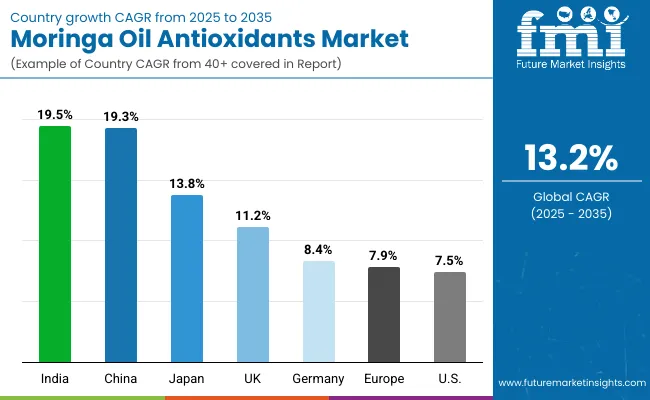
| Countries | Estimated CAGR (2025 to 2035) |
|---|---|
| China | 19.3% |
| USA | 7.5% |
| India | 19.5% |
| UK | 11.2% |
| Germany | 8.4% |
| Japan | 13.8% |
The global Moringa Oil Antioxidants Market shows significant regional variation in adoption, shaped by cultural alignment with botanicals, clean-label demand, and regulatory frameworks for natural skincare.
Asia-Pacific emerges as the fastest-growing region, led by India (19.5%) and China (19.3%). Growth in India is driven by strong Ayurvedic positioning, rising disposable incomes, and rapid expansion of e-commerce in tier-2 and tier-3 cities. In China, consumer trust in natural/organic formulations, regulatory support for plant-based cosmetics, and cross-border beauty platforms are fueling adoption. Japan (13.8% CAGR) continues to see robust growth, supported by demand for multifunctional anti-aging and moisturizing products backed by clinical validation.
Europe maintains a strong profile, led by the UK (11.2%) and Germany (8.4%), where strict EU cosmetic regulations and consumer preference for dermatologist-tested, sustainable products underpin growth. Brands emphasize traceability, eco-friendly packaging, and premium natural actives to meet evolving consumer expectations.
North America shows more moderate expansion, with the USA at 7.5% CAGR. The market is mature but continues to expand through premium positioning, clean-label claims, and growing consumer interest in plant-based antioxidants. Growth is concentrated in e-commerce and specialty beauty stores, where premium oils and serums are marketed with strong clinical and sustainability narratives.
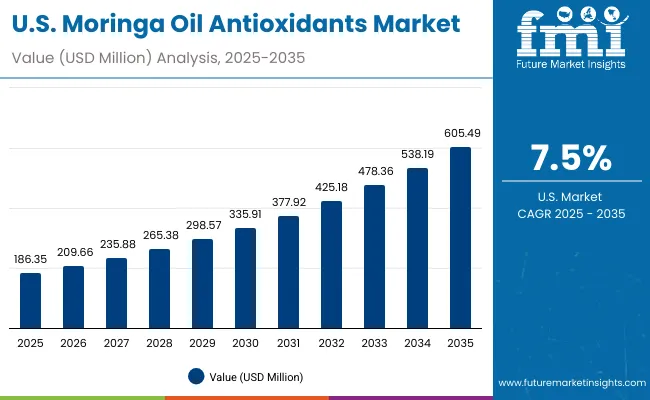
| Year | USA Moringa Oil Antioxidants Market (USD Million) |
|---|---|
| 2025 | 186.35 |
| 2026 | 209.66 |
| 2027 | 235.88 |
| 2028 | 265.38 |
| 2029 | 298.57 |
| 2030 | 335.91 |
| 2031 | 377.92 |
| 2032 | 425.18 |
| 2033 | 478.36 |
| 2034 | 538.19 |
| 2035 | 605.49 |
The Moringa Oil Antioxidants Market in the United States is projected to grow at a CAGR of 7.5%, expanding from USD 186.4 million in 2025 to USD 605.5 million in 2035. Growth is driven by strong demand for anti-aging formulations, which hold a 54.9% share in 2025, reflecting consumer preference for natural alternatives to synthetic antioxidants. Premium serums and oils are the most popular product types, marketed with dermatologist-tested and clean-label claims. The market is further fueled by the rise of e-commerce and specialty beauty retailers, which provide platforms for both established and indie brands to reach health-conscious consumers.
The Moringa Oil Antioxidants Market in the United Kingdom is expected to grow at a CAGR of 11.2%, supported by increasing consumer demand for clean-label, plant-based, and multifunctional skincare products. Premium oils and serums enriched with moringa antioxidants are gaining traction in pharmacies, specialty beauty retailers, and e-commerce platforms. The UK consumer base places strong emphasis on sustainability, eco-friendly packaging, and traceable sourcing, which has led brands to highlight ethical supply chains and certifications. Academic collaborations, government-backed sustainability programs, and indie brand innovation are further accelerating the adoption of moringa oil antioxidants in both premium and mass segments.
India is witnessing rapid growth in the Moringa Oil Antioxidants Market, which is forecast to expand at a CAGR of 19.5% through 2035, making it the fastest-growing market globally. This momentum is supported by the country’s strong Ayurvedic heritage, which aligns naturally with moringa oil’s positioning as a multifunctional botanical antioxidant. Demand is rising not only in metropolitan cities but also across tier-2 and tier-3 markets, driven by increasing awareness of herbal skincare, affordability of oils and serums, and rapid penetration of e-commerce platforms. Domestic players and global suppliers are actively collaborating with Indian beauty brands to introduce localized formulations that cater to diverse skin types and climatic conditions.
The Moringa Oil Antioxidants Market in China is expected to grow at a CAGR of 19.3%, the highest among leading economies. Growth is driven by increasing consumer demand for natural/organic skincare solutions, which already account for 52.5% share in 2025. Chinese consumers are highly receptive to plant-based formulations, and moringa oil antioxidants are being marketed as premium yet multifunctional actives with strong anti-aging and moisturizing benefits. Domestic beauty brands are capitalizing on affordability and scale, while international players strengthen their presence through cross-border e-commerce platforms. Regulatory support for clean-label cosmetics and expanding digital beauty ecosystems continue to accelerate adoption.
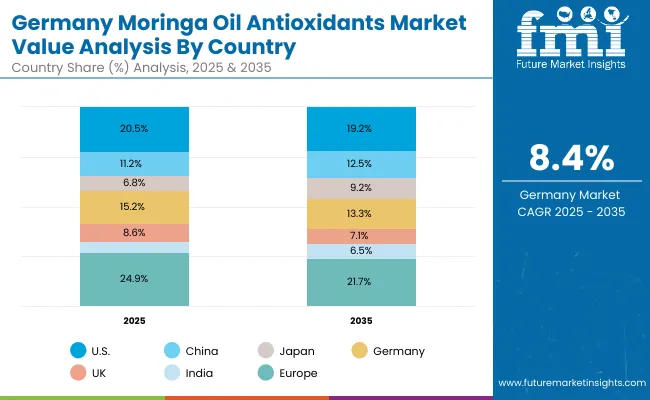
| Countries | 2025 Share (%) |
|---|---|
| USA | 20.5% |
| China | 11.2% |
| Japan | 6.8% |
| Germany | 15.2% |
| UK | 8.6% |
| India | 5.3% |
| Countries | 2035 Share (%) |
|---|---|
| USA | 19.2% |
| China | 12.5% |
| Japan | 9.2% |
| Germany | 13.3% |
| UK | 7.1% |
| India | 6.5% |
The Moringa Oil Antioxidants Market in Germany is projected to grow at a CAGR of 8.4%, supported by strong demand for premium, clinically validated natural skincare. Germany’s skincare market is heavily influenced by regulatory compliance under EU standards, which prioritize safety, traceability, and clean-label transparency. This has positioned moringa oil antioxidants as a favored ingredient in dermatologist-tested formulations, particularly in anti-aging and moisturizing creams. German consumers also value eco-friendly packaging and sustainable sourcing, making these attributes critical for brand differentiation. Despite its robust base, Germany’s global share is expected to decline slightly from 15.2% in 2025 to 13.3% in 2035, reflecting faster growth in Asia-Pacific.
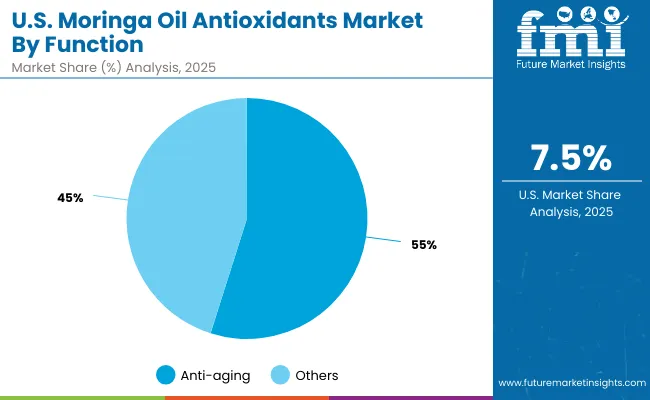
| USA by Function | Value Share% 2025 |
|---|---|
| Anti-aging | 54.9% |
| Others | 45.1% |
The Moringa Oil Antioxidants Market in the United States is projected at USD 186.4 million in 2025, with the anti-aging segment leading at 54.9%. Growth in this segment is fueled by rising consumer demand for plant-based alternatives to synthetic antioxidants, as moringa oil is rich in vitamin E and essential fatty acids that target oxidative stress and fine lines. Moisturizing and repair claims support the “others” category, but premium serums and oils marketed for anti-aging remain the key revenue drivers. Expansion is reinforced by clean-label positioning, dermatologist-tested claims, and rising adoption of moringa formulations in both premium beauty and mass retail.
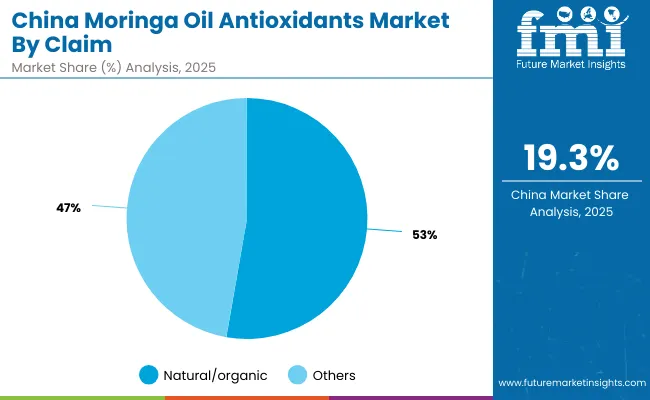
| China by Claim | Value Share% 2025 |
|---|---|
| Natural/organic | 52.5% |
| Others | 47.5% |
The Moringa Oil Antioxidants Market in China presents strong opportunities, with natural/organic products leading at 52.5% share in 2025. Rising consumer preference for clean, plant-based beauty solutions creates fertile ground for moringa oil, particularly in serums and oils marketed for anti-aging and moisturizing. Cross-border e-commerce platforms are expanding access to premium international brands, while domestic players leverage affordability and scale to drive penetration in mass retail. Regulatory initiatives promoting safe, herbal-based formulations further boost market confidence. The next growth wave lies in premiumization and sustainability, as younger consumers increasingly demand ethically sourced, eco-friendly skincare solutions.

| Company | Global Value Share 2025 |
|---|---|
| Marico | 7.8% |
| Others | 92.2% |
The Moringa Oil Antioxidants Market is moderately fragmented, with a mix of global ingredient suppliers, regional beauty players, and niche natural product specialists. Marico leads with a 7.8% share, leveraging its strong heritage in plant-based personal care and extensive distribution in Asia. Global suppliers such as BASF, Croda, and Ashland are key players, focusing on high-quality moringa oil extracts, standardization, and integration into premium skincare formulations.
Mid-sized innovators like Aldivia, KuliKuli, and Botanic Innovations emphasize sustainability, fair-trade sourcing, and clean-label certifications, strengthening their presence in both mass and premium categories. Ayurvedic-inspired companies such as Himalaya and Grenera are expanding adoption across South Asia, aligning moringa oil with cultural and herbal wellness traditions.
Competitive differentiation is shifting from raw material supply toward branded ingredient positioning, clinical validation, and sustainability-driven storytelling. Increasingly, companies are highlighting eco-friendly packaging, traceability, and multifunctional benefits to capture the growing consumer base seeking safe, natural, and holistic skincare.
Key Developments in Moringa Oil Antioxidants Market
| Item | Value |
|---|---|
| Quantitative Units | USD 910.4 Million |
| Function | Anti-aging, Moisturizing, Brightening, Repair |
| Product Type | Oils, Serums, Creams/lotions, Masks |
| Channel | E-commerce, Pharmacies, Mass retail, Specialty beauty stores |
| Claim | Natural/organic, Clean-label, Vegan, Ayurvedic -inspired |
| Regions Covered | North America, Europe, Asia-Pacific, Latin America, Middle East & Africa |
| Country Covered | United States, Canada, Germany, France, United Kingdom, China, Japan, India, Brazil, South Africa |
| Key Companies Profiled | Aldivia, Kuli Kuli, Botanic Innovations, Grenera, Himalaya, BASF, Croda, L’Oréal, Ashland, Marico |
| Additional Attributes | Dollar sales by function (anti-aging, moisturizing, brightening, repair), product type revenue assessment across oils, serums, creams/lotions, and masks, adoption trends in clean-label and vegan skincare, rising demand for multifunctional and portable beauty formats (serum capsules, oils-on-the-go), sector-specific growth in premium skincare, Ayurvedic formulations, and cosmeceuticals, revenue segmentation by natural/organic vs. synthetic blends, integration of sustainability narratives with eco-friendly packaging and traceable sourcing, regional trends influenced by regulatory support for herbal cosmetics, and innovations in cold-press extraction, bioactive concentration, and clinical validation of antioxidant efficacy. |
The global Moringa Oil Antioxidants Market is estimated to be valued at USD 910.4 million in 2025.
The market size for the Moringa Oil Antioxidants Market is projected to reach USD 3,150.3 million by 2035.
The Moringa Oil Antioxidants Market is expected to grow at a 13.2% CAGR between 2025 and 2035.
The key product types in the Moringa Oil Antioxidants Market are oils, serums, creams/lotions, and masks, reflecting their wide use across skincare applications, from anti-aging to moisturizing.
In terms of product type, the oils segment is projected to command the most significant share in the Moringa Oil Antioxidants Market in 2025, driven by its versatility, concentration of antioxidants, and multifunctional appeal across natural and clean-label skincare.






Full Research Suite comprises of:
Market outlook & trends analysis
Interviews & case studies
Strategic recommendations
Vendor profiles & capabilities analysis
5-year forecasts
8 regions and 60+ country-level data splits
Market segment data splits
12 months of continuous data updates
DELIVERED AS:
PDF EXCEL ONLINE
Moringa Tea Market Size and Share Forecast Outlook 2025 to 2035
Global Moringa Products Market Outlook – Trends, Demand & Forecast 2025–2035
Moringa Extract Market Analysis by Product Type, Form, End Use, Distribution Channel and by Region from 2025 to 2035
Oil and Gas Sensor Market Forecast Outlook 2025 to 2035
Oil Packing Machine Market Forecast and Outlook 2025 to 2035
Oil and Gas Pipeline Coating Market Forecast and Outlook 2025 to 2035
Oilfield Scale Inhibitor Market Size and Share Forecast Outlook 2025 to 2035
Oil-in-Water Anionic Emulsifier Market Size and Share Forecast Outlook 2025 to 2035
Oil and Gas Field Services Market Size and Share Forecast Outlook 2025 to 2035
Oil Control Shampoo Market Size and Share Forecast Outlook 2025 to 2035
Oil Expellers Market Size and Share Forecast Outlook 2025 to 2035
Oilfield Stimulation Chemicals Market Size and Share Forecast Outlook 2025 to 2035
Oiler Kits Market Size and Share Forecast Outlook 2025 to 2035
Oil Pressure Sensor Market Size and Share Forecast Outlook 2025 to 2035
Oil Filled Power Transformer Market Size and Share Forecast Outlook 2025 to 2035
Oily Skin Control Products Market Analysis - Size and Share Forecast Outlook 2025 to 2035
Oil Immersed Shunt Reactor Market Size and Share Forecast Outlook 2025 to 2035
Oil Country Tubular Goods Market Size and Share Forecast Outlook 2025 to 2035
Oil Filled Distribution Transformer Market Size and Share Forecast Outlook 2025 to 2035
Oilfield Communications Market Size and Share Forecast Outlook 2025 to 2035

Thank you!
You will receive an email from our Business Development Manager. Please be sure to check your SPAM/JUNK folder too.
Chat With
MaRIA